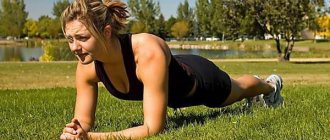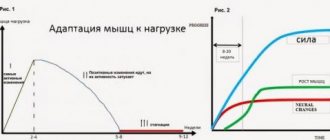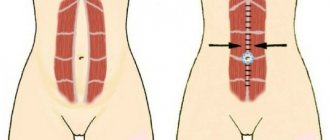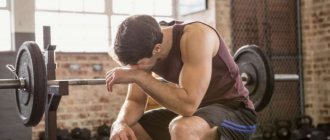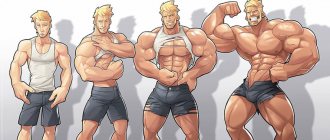Any physical activity involves the work of not just one muscle, but a whole group. And in order to create optimal conditions for the development of a particular group, it is necessary to focus your efforts on it, using different exercise machines and athletic equipment, changing body posture and the structure of movements.
Let's list the main muscle groups that a novice athlete will have to develop.
Neck muscles
In this group, the sternocleidomastoid muscle, thanks to which a person tilts and turns his head, is of primary interest to the athlete. In addition, this muscle helps lift the chest. Equally important for the harmonious development of the body are the anterior, middle and posterior scalene muscles, which are located deep in the neck, take part in the movement of the spine and raise the chest when inhaling.
This group also includes the deltoid muscle, which makes the shoulder round. The muscle consists of 3 bundles:
- the front one, which ensures that the arm is raised forward and rotates inward;
- the middle one, with the help of which the hand is moved to the side;
- the rear one, which moves the arm up and back and rotates it outward.
Pectoral muscles:
- pectoralis major muscle. One of the main muscles of this group, which brings the arm to the body and rotates it;
- serratus anterior muscle. Responsible for rotation and abduction of the scapula from the spine, raising the arm above the head;
- pectoralis minor muscle. Located under the pectoralis major muscle, lowers the arm to the body;
- intercostal muscles. Promotes breathing movements.
- latissimus dorsi muscle. Turns the arm inward, brings it to the body, tilts the body itself, participates in the movements of the entire shoulder girdle and gives the torso a cone-shaped shape;
- trapezius muscle. Provides lifting, rotation and bringing together of the shoulder blades, moving the head back;
- long muscles. They pass along the entire spine, tilt, extend and rotate the torso.
Abdominal muscles
Emphasize the waist, provide a slim and fit figure. In addition, they maintain the correct position of internal organs and promote normal intestinal function. The most important:
- 8 rectus abdominis muscles. Bend the torso, pull the legs to the chest;
- The oblique muscles provide flexion and rotation of the torso.
Arm muscles
This is one of the main decorations of a bodybuilder. The main ones are:
- biceps (biceps brachii muscle). Flexes the arm at the elbow joint, ensures abduction and adduction of the arm when turning the hand palm up (supination);
- triceps (triceps brachii muscle). Extends the arm at the elbow joint and takes it back;
- muscles of the forearm. Their main function is to flex and extend the fingers, providing all movements of the fingers and hand.
Leg muscles
They account for about half of all human muscle mass. The most important of them:
- quadriceps femoris muscle. Extends the leg at the knee joint, bends the hip, turns the leg outward and inward;
- gluteus maximus muscle. With its help, the hip extends and rotates outward;
- biceps (biceps femoris). This muscle bends the leg at the knee joint, rotates it outward, and extends it at the hip joint;
- calf muscle . Provides flexion of the leg at the knee joint
We began to get acquainted with the planar training system
- today’s advanced training methodology.
Before you begin looking at each group of exercises, it is necessary to lay down some basic anatomy. Subsequent articles will focus on muscles, so it is important to know the main muscle groups and what movements they perform.
The article is theoretical, but it contains pictures of the human muscular corset, which, in principle, should somehow dilute the slight boredom of the lecture :-) Moreover, there is very little material.
Content
- 1 Definition of strength
- 2 Types of strength and their importance in training 2.1 Strength: its qualities 2.1.1 Maximum strength
- 2.1.2 Power
- 2.1.3 Muscular endurance
- 2.2.1 Starting force
- 2.3.1 Concentric force
- 2.4.1 Absolute strength
- 2.5.1 Overall strength
- 3.1 Testing
Building a training session based on an algorithm
In order to build a conditional algorithm for choosing exercises for a training program, let’s summarize all of the above. And this is what we get.
STEP 1
Beginners to bodybuilding should first of all turn to training with light weights. The number of repetitions for such a workout is in the range of 12–20 times. This will increase the branching and cross-section of the vessels penetrating the muscles, which in turn will ensure the effectiveness of training and the growth of muscle mass. Another “plus” of training with light weights for beginners is that without being distracted by the weight, you can fine-tune your technique.
STEP 2
Providing muscle tissue with the proper number of nerves is innervation. We mentioned this important process at the very beginning of the article.
STEP 3
Hyperplasia. In this case, you should resort to high-volume training or pumping. In the first case, you will have to reluctantly overcome the monotony of training; in the second, you will have to suffer from the labor-intensive nature of the program, since correct pumping is quite labor-intensive. Choose what you like best.
STEP 4
Hypertrophy. At the first stage, take care of plyometrics with the help of “explosive” exercises, and at the second, start strength training.
For strength training, weights with which you can do 5-8 repetitions are most suitable. First, choose the maximum weight that will allow you to perform 5 repetitions, and gradually work your way up to 8 repetitions. After you begin to do 8 repetitions with the selected weight, choose a larger weight and start again with 5 repetitions.
Make sure that at each subsequent workout you make progress, or at least repeat the previous program. That is, your weight, the number of sets or repetitions cannot be less in relation to previous classes. If you cannot exercise at the same pace as in the last workout, your workouts are too frequent and your body does not have time to recover.
Then hyperplasia and hypertrophy alternate. Whether to use “pharma” is up to you. The only thing that can be said is that at first it is of no use. And finally, the main thing: no matter how your training goes at first, don’t give up, only then will you achieve the desired result.
Definition of strength[edit | edit code]
Physical strength
human is the ability to move a load overcoming resistance. The load can be someone's body, a shovel with snow, a dumbbell with disks, or any other objects. The resistance is usually the gravitational force of the Earth, which cannot be separated from the load, because the weight of the load is defined as the amount of force that is necessary to lift this load from the center of the Earth. There are other forms of resistance that are not related to the force of gravity, such as, for example, elastic resistance, which can be overcome by stretching a spring, or frictional resistance, which is overcome when pulling a sled.
There are many forms of muscle strength, each specific to a particular function:
- Maximum strength
- Explosive strength or muscle power or speed strength (in which reactive force is separately distinguished)
- Strength endurance
- Speed-strength endurance
Many factors contribute to the development of physical strength in a person's muscles, and not all of them are related to musculature. For example, if you have short limbs (arms and legs), this may help you perform certain strength tasks because the distance to carry the load will be shorter. For example, long legs and arms put you at a disadvantage when performing bench presses or squats (but these properties help when performing deadlifts).
To increase strength indicators, sports pharmacology, ergogenic aids and sports nutrition are actively used.
Two main properties
The factors that influence muscle strength are muscle cross-sectional area and neuromuscular efficiency. The cross-sectional area of muscles is responsible for muscle density. Typically, the denser a muscle becomes, the more force it can exert. This is partly because denser muscles have denser muscle fibers, and denser muscle fibers typically contain more contractile protein, which is the primary mechanism for muscle contraction. Increasing the amount of contractile protein in muscle fibers is like adding another person to your side in a tug of war.
Muscle performance
The work of a muscle is measured by the product of the mass of the load it lifts by the height of its lifting or by the path, therefore, by the height of muscle contraction. The universal unit of work, as well as the amount of heat, is the joule (J). The performance of a muscle varies depending on its physiological state and load. As the load increases, the muscle work initially increases, and then, after reaching the maximum value, it decreases and reaches zero. The initial increase in work with increasing load depends on the increase in the ability of the muscle to be excited and on the increase in the height of contraction. The subsequent decrease in work depends on the decrease in muscle contractility due to increasing stretching by the load. The amount of work depends on the number of muscle fibers and their length. The larger the cross-section of the muscle, the thicker it is, the greater the load it can lift.
The pennate muscle can lift a large load, but since the length of its fibers is less than the length of the entire muscle, it lifts the load to a relatively small height. The parallel muscle can lift a smaller load than the pennate muscle, since its cross-section is smaller, but the height of the lift is greater, since the length of its muscle fibers is greater. Provided that all muscle fibers are excited, the height of muscle contraction, other things being equal, is greater the longer the fibers. The amount of work is affected by the stretching of muscle fibers by a load. Initial stretching with small loads increases the height of contraction, and stretching with large loads decreases the height of contraction of the muscle. The work of a muscle also depends on the number of myoneural apparatuses, their location and their simultaneous excitation. When fatigued, muscle work decreases and may stop; The height of muscle contraction decreases as fatigue develops and then reaches zero.
Types of strength and their importance in training[edit | edit code]
Source: "Training Programs"
, scientific ed.
Author:
Professor, Doctor of Science Tudor Bompa, 2020
Training may require different types of strength, each of which is important for a particular sport and athlete. Types of force can be differentiated by the quality of the force, the force-time curve, the type of muscle activity, the athlete's body weight, and the degree of specificity.
Strength: its qualities[edit | edit code]
The desired effects of a strength training method always fall into one of three categories or qualities: maximum physical strength, power, and muscular endurance.
Maximum strength[edit | edit code]
Maximum strength
- this is the maximum force that the neuromuscular system can produce during contraction. This quality is enhanced through a combination of structural adaptation (hypertrophy) and, for the most part, neural adaptation (mainly in the form of improved intermuscular and intramuscular coordination). Maximum strength is determined by the heaviest load an athlete can lift in one attempt and is expressed as a 100 percent maximum. For training purposes, athletes must know their maximum strength level for their most important (fundamental) exercises, as this provides the basis for load calculations for almost every phase of strength training.
Power[edit | edit code]
Power
is the product of two abilities: strength and speed - and is itself the ability to apply maximum force in the shortest period of time. Unlike powerlifting, where athletes express (maximum) force without a time limit, athletes in other sports face time limits within which they must produce the maximum force possible. Examples include kicking by running athletes in individual and team sports, punching and kicking in combat sports, and the swing and throw of baseball. Power is trained by methods that enhance the rapid expression of force, thereby improving the thermal energy expenditure of active motor units. Power can only be increased through the use of specific techniques after the maximal strength training phase.
Muscular endurance[edit | edit code]
Muscular endurance
- this is the ability of a muscle to maintain work over a long period of time. Most sports require endurance, and muscular endurance training techniques develop both the neural and metabolic aspects of a particular sport. We distinguish four types of actual sports methods of training muscular endurance: strength endurance (10-30 seconds or up to 15 seconds with incomplete rest; lactate power), short muscular endurance (30 seconds - 2 minutes; lactate performance), average muscle endurance (2- 8 minutes; aerobic power) and long-term muscular endurance (more than 8 minutes; aerobic performance).
Force: force-time curve[edit | edit code]
Force-Time Curve
If we analyze the force-time curve (see figure), we can distinguish the following types of force: starting force, explosive force (strength development range), power (starting force plus explosive force) and maximum force.
Starting force[edit | edit code]
Starting force
expressed at the onset of concentric action and usually measured after 50 milliseconds. Its level depends on the ability to voluntarily recruit as many motor units (i.e. intramuscular coordination) as possible at the beginning of the movement.
Explosive power or rate of force development[edit | edit code]
Explosive force
is the rate of increase in strength at the beginning of a concentric exercise. Its level depends on the ability to recruit more motor units or increase the energy expenditure of active units to increase force production.
Power[edit | edit code]
Starting force and explosive force together represent what we call power, or, according to other authors, "velocity force." High levels of power are generally required to achieve high performance in sports, as some sports have restrictions on the use of force.
Maximum strength[edit | edit code]
Maximum strength
is the maximum level of force an athlete can achieve in a movement.
Strength: muscle activity[edit | edit code]
Three types of force can be distinguished according to muscle activity: concentric, isometric and eccentric.
Concentric force[edit | edit code]
With concentric action
the muscle tenses and contracts, thereby moving the joint. Maximum strength is usually measured by the largest load that can be lifted concentrically. An eccentric action usually either precedes or follows it.
Isometric strength[edit | edit code]
With isometric action
the muscle tenses without contracting or stretching; this result is obtained when the generated force is equal to the external resistance or when the external resistance is stationary. A high proportion of isometric primary muscle activity is required for many movement sports, as well as cycling motocross, sailing and combat sports. The need for such actions should be taken into account when designing a strength training program. Isometric strength can exceed concentric strength by 20 percent.
Eccentric strength[edit | edit code]
With eccentric action
the muscle creates less tension than external resistance, thus the muscle stretches. High levels of eccentric strength are recommended for sports that require jumping, sprinting, and changing direction. Eccentric force can exceed concentric force by 40 percent.
Strength: relation to body weight[edit | edit code]
Maximal strength training techniques produce both neural and muscular adaptations. As described below, load parameters can be manipulated to increase either the athlete's body mass and strength, or strength alone, while maintaining body weight. For this reason, we distinguish two types of power: absolute and relative.
Absolute power[edit | edit code]
Absolute Power
is the athlete’s ability to produce maximum force regardless of body weight. A high level of absolute strength is required to excel in some sports (such as shot put and the heaviest categories in weightlifting and wrestling). Increases in strength parallel gains in body mass for those athletes who train to increase absolute strength.
Relative strength[edit | edit code]
Relative strength
is the relationship between maximum strength and body weight. High levels of relative strength are important in gymnastics, sports where athletes are categorized by weight (such as wrestling, boxing, judo, Brazilian jiu-jitsu and mixed martial arts), team sports that require frequent changes of direction, and sprinting. and jumping in athletics. For example, a gymnast may not be able to perform a vertical support on the rings until the ratio of the relative strength of the muscles involved is at least one to one; in other words, the absolute strength should be enough to at least compensate for the athlete’s body weight. Of course, increasing body weight changes the ratio - as body weight increases, relative strength decreases, unless it increases correspondingly. Therefore, training programs aimed at increasing relative strength do so by inducing neural adaptations to strength training rather than by increasing muscle mass and overall body mass.
Strength: degree of specificity[edit | edit code]
We distinguish two types of strength according to the degree of specific sports biomechanical and physiological similarity of the training tools and methods involved in the program: general strength and specific strength.
Overall strength[edit | edit code]
Overall Strength
- This is the basis of the entire training program. In the first years of sports training, it is important to focus on it. Low levels of overall strength can limit an athlete's overall progress. Because of this, the body may be susceptible to injury and perhaps even develop asymmetrically or have a reduced ability to accumulate muscle strength, as well as a lower ability to develop necessary sports skills.
Anatomical adaptation, hypertrophy, and maximal strength macrocycles are involved in the development of an athlete's overall strength. Anatomical adaptations focus on developing overall core strength as well as muscle balance and injury prevention through tendon strengthening. As the name suggests, anatomical adaptation prepares the body for subsequent, more complex stages. Overall strength increases further due to structural changes caused by macrocycles of hypertrophy and neural adaptations resulting from macrocycles of maximal strength.
Specific strength[edit | edit code]
Specific Strength Training
, take into account the characteristics of a particular sport, such as ergogenesis (contribution of energy systems), plane of movement, primary muscles, joint range of motion and muscle activity. As the name suggests, this type of strength is specific to each sport and requires significant analysis. Therefore, there is no point in comparing the strength levels of athletes involved in different sports. Specific strength training should be introduced gradually towards the end of the preparatory period for all advanced athletes.
Power reserve[edit | edit code]
Power Reserve
is the difference between maximum force and the force required to perform a skill under competitive conditions. For example, one study of strength techniques measured rowers' average strength per stroke during a race, which was found to be 56 kilograms[1]. The same athletes demonstrated absolute strength when lifting a weight of 90 kilograms on the chest. If we subtract the average strength during the race (56 kilograms) from the absolute strength (90 kilograms), we get a strength reserve of 34 kilograms. In other words, the ratio of average strength to absolute strength is approximately 1:1.6.
Other test athletes in the same study showed a higher strength reserve and a ratio of 1:1.85. Of course, the rowers of this group performed better in the boat race, thus confirming that an athlete with a greater reserve of strength is capable of demonstrating higher athletic performance. Therefore, the strength coach should strive to help athletes achieve the highest level of maximal strength during a weekly strength training session in a rational relationship with more specific sessions to prevent negative carryover.
Laws of optimal load and optimal rhythm
Since as the load increases, the height of muscle contraction decreases, the work, which is the product of the load and height, reaches its greatest value at some average loads. These average loads are called optimal.
All other things being equal, under optimal loads, the muscle retains its performance for the longest time. At optimal load, the performance of a muscle depends on the frequency of the rhythm of its contractions, i.e., on the frequency of uniform alternation of muscle contractions. The rhythm of muscle contractions at an average load, at which the longest muscle performance is maintained, is called optimal,
Different muscles have different optimal loads and optimal rhythms. They also change in a given muscle depending on working conditions and its physiological state.
Optimal load and optimal rhythm are determined primarily by the nervous system (I.M. Sechenov). As for a person, his mental and physical performance is determined by the social conditions of work (tools of labor, attitude to work, emotions, etc.). The optimal load and optimal rhythm for a person vary significantly depending on life experience, age, nutrition and training.
Read also[edit | edit code]
- Development of strength abilities
- Bodyweight training program
- Bodyweight strength exercises
- Strength training plan
- Strength training program
- Differences between training for strength and mass
- Functional movement abilities: mobility and stability
- Strength abilities
- Dynamometry (method of measuring muscle strength)
- Tests to assess absolute muscle strength using barbells and extreme weights
- Tests to assess speed-strength abilities and power
- Tests to evaluate the special strength abilities of field players
- Doping and sports pharmacology for strength development
Which training program should I focus on?
World-famous bodybuilders, who more than once took the highest places for their achievements, had their own training programs, which were radically different from each other. Sergio Oliva worked out in the gym for about two hours, as he only recognized volume training. Short classes were to the taste of Dorian Yates, who placed the main emphasis on “refusal”. In turn, Ronnie Coleman was categorically against “failure” sessions, and insisted that the muscles should be “punched” using a large number of sets. Jay Cutler had the same long workouts as Oliva, but he emphasized comfortable weights, working with them for 12-20 repetitions.
Why, using fundamentally different approaches, did these athletes consistently achieve their goal? Which workout is optimal? How much time do you need per session and rest between sets? What amplitude should you use when performing the exercise? All these and many other questions will remain unanswered if you don’t first understand what increases muscle volume depends on.
Mechanism of muscle contraction
Muscle contraction occurs due to the sliding of actin filaments along the myosin filaments (sliding contraction), while the total length of the actomyosin complex , without changing the length of the actin and myosin filaments. A primary role in muscle contraction is played by temporarily closed cross bridges (heads of myosin molecules), which ensure the movement of actin filaments along the myosin filaments. Accordingly, the force of muscle contraction will depend on the bridges - the more bridges are attached to the actin filaments, the stronger the contraction.
The energy required for this “ sliding contraction ” is provided by the interaction of ATP with actomyosin, resulting in adenosine triphosphate (ATP) breaking down into adenosine diphosphate (ADP) and phosphoric acid (H3PO4).
Along with ATP, calcium, magnesium and water also play an important role in muscle fiber contraction .
The amount of water that muscle is approximately 72-80% , while muscle tissue also contains a large amount of proteins , and in small quantities glycogen , phospholipids, cholesterol, creatine phosphate, creatine, and vitamins.
The more muscle fibers there are in skeletal muscles, the stronger they will be.
The mechanism of human muscle contraction

